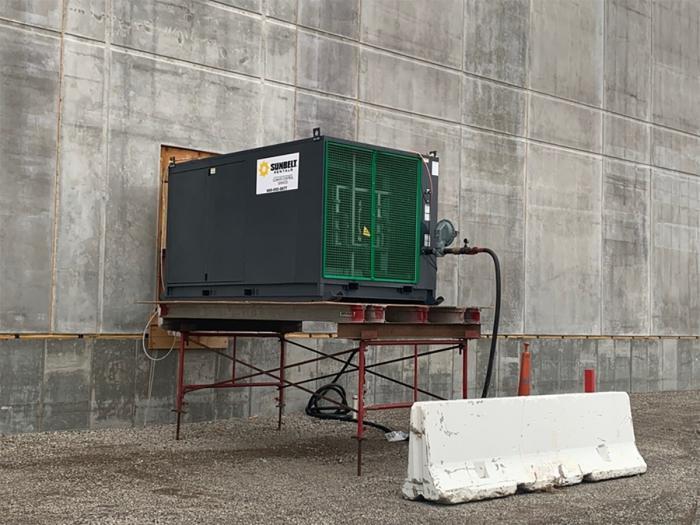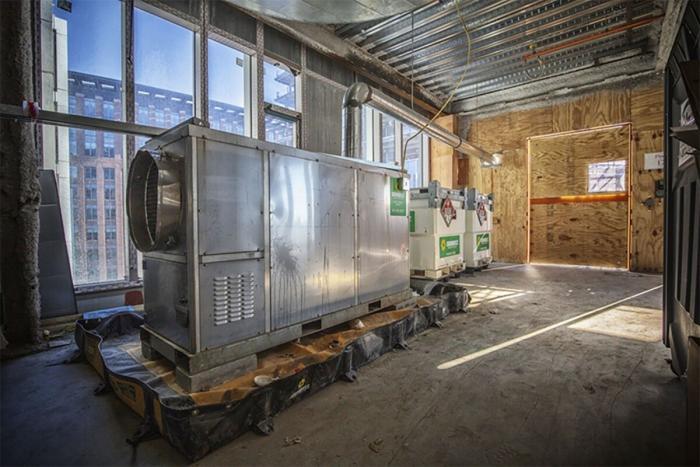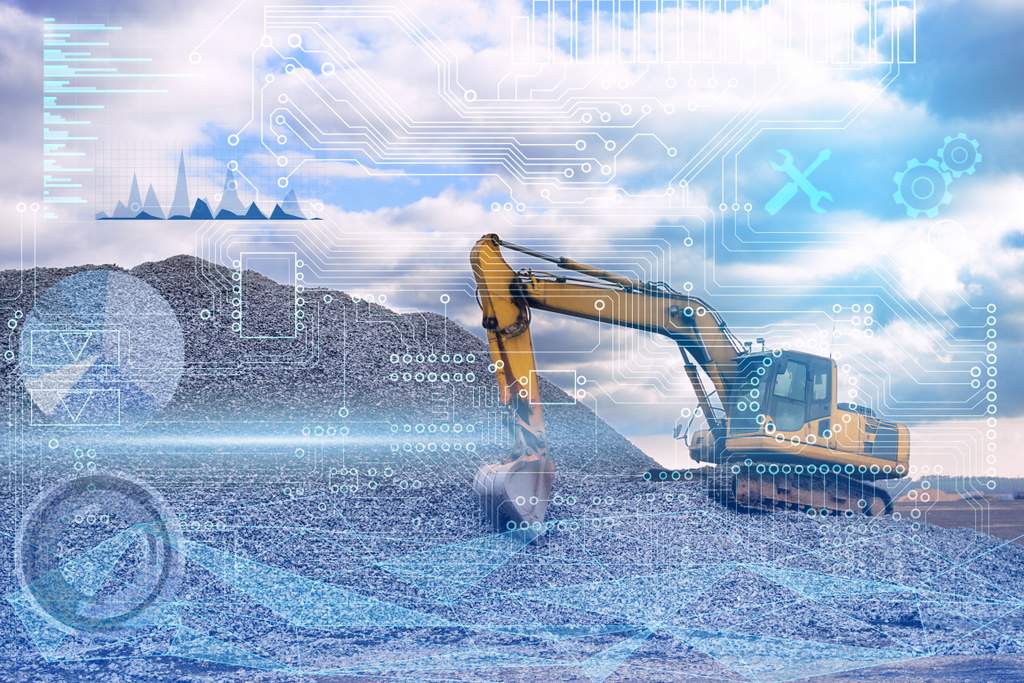Learn More About Temporary Heating Solutions for Construction Projects with Sunbelt Rentals

Construction projects come with a specific set of challenges — competitive bidding, tight deadlines, budget oversight, project delays and more. Add cold weather to the list and there is an entire set of other factors to consider. That’s where temporary heating solutions come in. From fireproofing and concrete curing to interior finishing trades like paint and drywall, there is a solution for each job. The key is to plan ahead for winter conditions with a properly designed heating solution and account for the expense as part of the design estimate. Having the most efficient heating solution in place can save money in the long term by keeping projects on schedule and minimizing the cost of labor and supplies to rework issues.
Rental equipment partners can help with estimating costs, selecting the right temporary heating solution, and addressing dehumidification needs that may accompany the project. They can also offer turnkey solutions where local codes allow — installation, setup, service support and removal — or work with qualified mechanical contractors and electricians during installation.
Key Considerations
When heating construction projects during winter conditions, there are several factors to keep in mind.
Safety should be the first consideration. Each type of heating solution has safety measures associated with proper system design, setup, and operation. For example, electrical heaters need to be installed by a qualified electrician using the appropriately sized cable to connect to the properly sized breakers; this helps eliminate fire and electrocution risks. Propane and natural-gas-fueled heaters should have all connections correctly secured and tested for leaks. Noxious exhaust fumes from indirect-fired heaters need to be vented outside any occupied space. Finally, consider the specific safety features built into each heater, as well as any third-party certifications such as the American National Standards Institute (ANSI), Underwriters Laboratories (UL) and Engineering Trade Linkers (ETL). Do not use heaters that lack specific safety features and certifications or where features have been modified or disabled.
A rental equipment partner can offer recommendations to help ensure the best results and the greatest cost savings. This is particularly true with regard to fuel and energy consumption since these are often more expensive than the cost of the heater rental itself. Having an efficiently designed system can save money on fuel. Some rental partners also offer more fuel-efficient options and can support contractors with fuel consumption estimates to keep projects on budget.
Each unit of fuel or energy has a corresponding BTU heating capacity. For example, one gallon of propane contains approximately 91,500 BTUs and one gallon of diesel fuel contains approximately 138,000 BTUs. Each KWh of electrical power can produce 3,412 BTU. A rental solutions provider can determine the lowest cost per BTU based on local fuel and energy prices and recommend the solution with the lowest operating cost for the project.
Choosing a Temporary Heating Solution
The size of the structure and its location, inside and outside design temperatures, and available fuel or energy supply are all determining factors in choosing a temporary heating solution. The construction stage of the enclosure also matters — whether it is wrapped in plastic or exterior walls and windows are in place.
Contractors rely on five main categories of temporary heaters to address their project needs: direct-fired recirculating, makeup air systems, indirect-fired, electric, and steam. Each has its advantages, limitations, and applications for which it is best suited.

Direct-fired recirculating heaters connect directly to a fuel source; 100% of the heat goes directly into the air, making them nearly 100% efficient. Almost all the fuel being burned is converted to usable heat, which is a big advantage. These heaters typically operate with propane or natural gas, so the burn is also clean, and they are typically set up as a recirculating system. In this situation, there is a burner in a tube that burns the fuel and a fan that blows air across the flame, heating the air and pushing it into the space. Since the heater is inside the space, it is said to “recirculate” the heated air. This is an inexpensive option for getting a lot of BTUs into buildings where the structure is loose or has some leakage from plastic wrap.
However, in structures with less ventilation, direct-fired recirculating systems create problems. While efficient, they do exhaust combustible byproducts into the space. One of the main byproducts of combustion is water molecules. This water vapor can become an issue on a construction project by creating condensation and humidity. Another disadvantage is that since heat rises while being recirculated, distribution throughout the space can be inconsistent, leading to cold spots and stratification of warm air at the top of the structure. Even when using fans to move the heat around, the heat distribution can still be uneven.
Makeup air systems take fresh “makeup” air from outside the structure and pass it through an enclosed direct-fired burner. The burner heats the air directly and then blows the warm air into the structure through a duct or hard connection. Since the air is being heated directly by the flame, it is nearly 100% efficient. As the air is pushed out into the structure, it creates a pressurizing or “balloon” effect that forces the warm air into every area of the space. This results in very even heat distribution and minimal stratification. Also, because fresh air is constantly being added to the space, it minimizes buildup of combustion byproduct and reduces humidity. The result is a cleaner indoor environment.
Indirect-fired heaters utilize a burner that is contained within an “indirect” heat exchanger. Fuel is burned inside the heat exchanger and the exhaust gas from combustion is expelled via a flue stack. Air is brought in by a blower and forced across the heat exchanger to be heated indirectly, thus providing 100% clean, dry air. This system also eliminates concerns about combustion byproducts or moisture associated with direct-fired heaters. Since the exhaust gas is not going into the space, the heaters can use diesel fuel, natural gas, or propane. Indirect-fired heaters can be set up in either a makeup-air or recirculating configuration. However, the exhaust gas is both hot and noxious, so setup requires careful attention, particularly in a recirculating configuration. A rental solution partner can recommend the best configuration and design it properly.
Indirect-fired heaters are well suited to projects where there is a concern about moisture or humidity or when the structure needs to remain very clean, such as during an expansion or renovation at a hospital.
The tradeoff to the 100% clean, dry air provided by indirect-fired heaters is a loss of efficiency. Since they heat the air indirectly through a heat exchanger, there is a loss of approximately 20% to 25% for every BTU of fuel consumed. This loss of efficiency increases the cost of operating an indirect-fired heater compared to direct-fired solutions.
Electric heaters are used when fuel is not an available option. While they are very clean sources of heat, the heat output is only about 3,400 BTUs per KWh of power consumed. Some simple math will show that the cost per BTU is typically highest for electricity being purchased by the KWh. Contractors are also limited on the size or number of BTUs available from an electric system due to the power that’s typically available in a building during construction.
Where adequate power is available, electric heat is a viable option with no concerns about combustion exhaust or fuel supply. Electric heaters typically feature a small fan to distribute heat via convection; however, heat distribution can be poor without the use of additional fans. Electric radiant heaters without fans have the poorest heat distribution.
Steam heaters use either hot water or steam to heat a radiator equipped with a fan to transfer the heat through convection. If a construction project has access to steam or hot water from a permanent or temporary boiler system, or even a hot water system, contractors may be able to utilize this solution. That access could occur during a renovation or expansion of a facility such as a hospital or university, particularly in older cities where they often have this type of infrastructure.
Steam heaters offer the advantage of being inexpensive to rent and depending on the source, the steam or hot water may be low cost or free. There is also no concern about moisture since they don’t operate by way of combustion; they offer clean, dry heat. There are, however, safety considerations when working with live steam. These heaters should only be connected by qualified personnel.
Getting the Best Results
With the various advantages and limitations of available temporary heating solutions, it may be difficult to decide on which is the best for the job. Ideally, the most efficient system will be the lowest cost system because it provides the best heat output for the lowest fuel expense.
But cost is just one factor in temporary heating. It’s critical that the solution is also the safest.
That’s why it’s important to work with an experienced rental solution partner to design the safest, most efficient solution and conduct a complete cost analysis. Doing so can help keep projects on time and on budget — and protect contractors and their staff.
Chris Claeys is the national sales manager construction – climate control services for Sunbelt Rentals.




